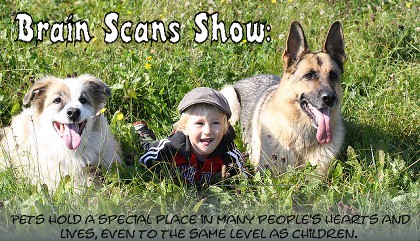The bond between pet and owner may be more similar to the relationship between child and parent than previously thought.
 Brain scans are helping scientists better understand the bond between people and their beloved pets.
Brain scans are helping scientists better understand the bond between people and their beloved pets.
The study included 14 women who had at least one child between the ages of 2 and 10 and one dog that had been in the household for two or more years. Imaging technology called functional MRI was used to monitor the women’s brain activity as they looked at photos of their children and their dogs.
Brain areas associated with emotion, reward, relationships and social interaction showed increased activity when the women saw the pictures of their children and their pets. A brain area involved in facial recognition and other visual processing functions showed greater response to their dogs than to their children.
However, a brain region involved in forming bonds with others became active only when the women saw photos of their children, according to the Massachusetts General Hospital (MGH) study published Oct. 3 in the journal PLoS One.
“Pets hold a special place in many people’s hearts and lives, and there is compelling evidence from clinical and laboratory studies that interacting with pets can be beneficial to the physical, social and emotional well-being of humans,” study co-lead author Dr. Lori Palley, of the MGH Center for Comparative Medicine, said in a hospital news release.
Previous studies have found that levels of hormones such as oxytocin — which is involved in pair-bonding and maternal attachment — rise after interaction with pets, she said. “And new brain imaging technologies are helping us begin to understand the neurobiological basis of the relationship, which is exciting,” she added.
Study co-lead author Luke Stoeckel acknowledged this is a small study that might not apply to a larger group of people. Still, “the results suggest there is a common brain network important for pair-bond formation and maintenance that is activated when mothers viewed images of either their child or their dog,” Stoeckel said in the news release.
The researchers said the similarities and differences in brain activity revealed by functional neuroimaging could eventually help explain the complexities underlying human-animal relationships.
Additional, larger studies are needed to replicate these findings and to see if they also occur in other groups of people, such as fathers, women without children, and parents of adopted children, and with other types of pets, they added.
